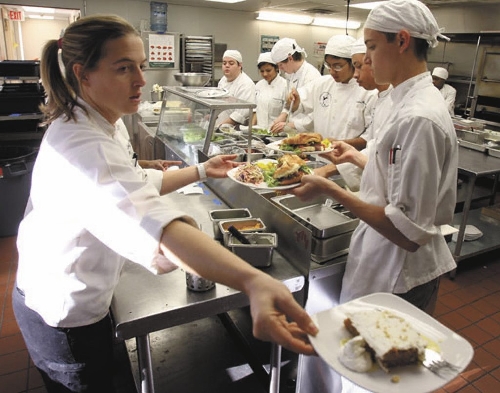Career academy to get some work

Chefs are used to working "in back of the house," their term for kitchen.
At the dilapidated Southeast Career Technical Academy, the student chefs work so far in the back they’re in a separate building. Prepared food must be transported a short distance outside and then carted up a service ramp to the Adler Dining Hall, the school restaurant.
"We have lost some soup," culinary arts instructor Emily Herrin said. "Top heavy things seem to fall, but it has not been too bad. I think the kids love a challenge."
The facility itself has become a challenge to academy staff and students. Because of deteriorating concrete, which Clark County School District building officials suspect wasn’t mixed properly during construction in the mid-1960s, the school requires a major overhaul. This year, the second floor of the main classroom building was closed because of safety concerns. Classes had to be relocated to 40 portable units.
"I wasn’t too sure how it would work at first, but as soon as I walked through the portables and learned my new classes, I got used to it," Southeast senior Jarrod Scoggins, 17, said.
Structural changes made over the years created passages that go nowhere, such as a stairway in the library that ends at a wall.
The career academy, which is home to the school district’s only cosmetology program, is about to get a makeover. The Clark County School Board on Wednesday approved $31.5 million for demolition and reconstruction of much of the hilltop campus, off Mountain Vista Street just south of Russell Road. The project will be paid for with savings from other bond-funded projects that have come in under budget.
School Board member Chris Garvey compared the project’s funding to finding loose money "in the couch."
The board gave unanimous approval to allow work to start as soon as possible, but the decision was not without debate because the district has many other pressing needs. School Board member Deanna Wright said that Boulder City High School is also an older school in need of renovation.
The district estimates it will have $4.9 billion in unfunded capital needs over the next 10 years. Over half of the district’s buildings will be more than 20 years old within the next five years, which is usually when a building needs repairs and renovations, said Jeff Weiler, the district’s chief financial officer.
Because the 1998 bond program is winding down, the district’s Bond Oversight Committee urged the School Board and district staff to consider tapping into its $74 million land acquisition fund to help pay for other priority projects, especially because the district’s enrollment growth has been flat over the past few years and new schools are not needed as they were during the boom years.
As the last major expense of the 1998 bond program, which provided $4.9 billion for 101 new schools and 11 replacement schools, the Southeast project was chosen because of safety, efficiency and equity concerns.
With the deteriorating buildings, district officials are concerned about a fault line that intersects the campus from north to south. It runs parallel to the school gym, but it is not under the major facilities, according to a district map.
Geological studies have confirmed the land to be safe, but district officials would like to reconfigure the campus to make buildings farther away from the fault line.
Because the district has opened four new career academies within the past three years, it has prototype designs to expedite the planning for the makeover of Southeast, the oldest vocational school in Clark County.
The academy would get amenities such as a larger, modernized kitchen, comparable with the facilities at the new academies, said Robert Sisk, a culinary instructor.
"We’re beginning to get something like the others have, although in a way, I don’t know if I want something quite that big," Sisk said. "There are too many places for (students) to hide and get lost. Here, I can yell and I can get everybody."
While the current situation is not "optimal," Southeast Principal Richard Arguello is proud of the school’s success in maintaining a 98 percent graduation rate and a 98 percent passing rate on the state’s proficiency exams, which all students have to pass to earn a diploma.
Southeast senior Ciro Fodera said he has been accepted into the Culinary Institute of America in Hyde Park, N.Y. He called it "the Harvard of culinary; it’s a big deal for me."
Besides working in the school’s restaurant, the 17-year-old also cooks for the Red Rock Country Club as an apprentice chef.
"I get home at nine (at night)," he said. "Then I wake up and start all over again."
Contact reporter James Haug at jhaug@reviewjournal.com or 702-383-4686.